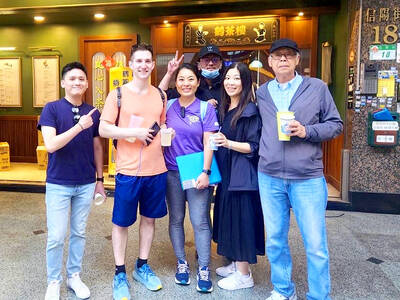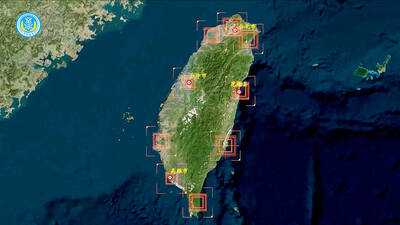In addition to lost-wax casting, which is favored by Tittot artists in Taipei, there are a number of modern techniques adopted by glass artists world-wide.
Of the three most important glass art centers in the world today, Prague, with a 400-year-old tradition in the industry, is best-known for its outstanding cutting techniques. Venice, on the other hand, possesses expertise in glass-blowing as well as hot forming. Seattle is distinguished for its installed art.
Sunny Wang (王鈴蓁), a Taiwan- and Australia-trained artist, says that compared with ceramics, mastering glass art techniques is more difficult and time consuming. It requires more expensive hardware and the cost of good-quality glass granules or powder is 10 times higher than the price of pottery clay in Taiwan.
Furthermore, the time taken for glass to anneal is around three days, whereas ceramics usually take one day. This means that the electricity bill for glasswork is up to three times higher than that of ceramic workshops. Also, glass art objects are generally cheaper than ceramic artifacts in Taiwan, which could be an indication that the local market for top-quality glasswork has not ripened yet.
Nevertheless, Wang still prefers glass art production. "I am simply fascinated by the transparency, rich colors and the unusual sense of space that glassware presents. It really cannot be found in any ceramic artworks."

A vaccine to fight dementia? It turns out there may already be one — shots that prevent painful shingles also appear to protect aging brains. A new study found shingles vaccination cut older adults’ risk of developing dementia over the next seven years by 20 percent. The research, published Wednesday in the journal Nature, is part of growing understanding about how many factors influence brain health as we age — and what we can do about it. “It’s a very robust finding,” said lead researcher Pascal Geldsetzer of Stanford University. And “women seem to benefit more,” important as they’re at higher risk of

Eric Finkelstein is a world record junkie. The American’s Guinness World Records include the largest flag mosaic made from table tennis balls, the longest table tennis serve and eating at the most Michelin-starred restaurants in 24 hours in New York. Many would probably share the opinion of Finkelstein’s sister when talking about his records: “You’re a lunatic.” But that’s not stopping him from his next big feat, and this time he is teaming up with his wife, Taiwanese native Jackie Cheng (鄭佳祺): visit and purchase a

April 7 to April 13 After spending over two years with the Republic of China (ROC) Army, A-Mei (阿美) boarded a ship in April 1947 bound for Taiwan. But instead of walking on board with his comrades, his roughly 5-tonne body was lifted using a cargo net. He wasn’t the only elephant; A-Lan (阿蘭) and A-Pei (阿沛) were also on board. The trio had been through hell since they’d been captured by the Japanese Army in Myanmar to transport supplies during World War II. The pachyderms were seized by the ROC New 1st Army’s 30th Division in January 1945, serving

The People’s Republic of China (PRC) last week offered us a glimpse of the violence it plans against Taiwan, with two days of blockade drills conducted around the nation and live-fire exercises not far away in the East China Sea. The PRC said it had practiced hitting “simulated targets of key ports and energy facilities.” Taiwan confirmed on Thursday that PRC Coast Guard ships were directed by the its Eastern Theater Command, meaning that they are assumed to be military assets in a confrontation. Because of this, the number of assets available to the PRC navy is far, far bigger